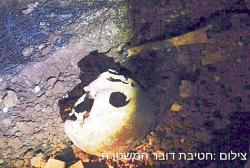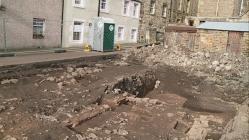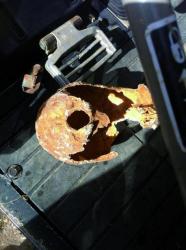INSTITUT SUPERIEUR D'ANTHROPOLOGIE
INSTITUTE OF ANTHROPOLOGY
ONLINE COURSES / COURS A DISTANCE
SUMMER TERM : JULY 2014
REGISTER NOW
ESPAGNE –  Artevigua- A cave located on Spain’s Canary Islands, in what was probably the aboriginal region of Artevigua, could reveal an unsuspected knowledge of astronomy by the ancient islanders since it marks equinoxes and solstices, while inside it the light recreates images related to fertility. The cave was used as a temple and, besides its astronomical function, the light creates in its interior a mythological account of fertility, the likes of which exist nowhere else in the world,” archaeologist Julio Cuenca, who has investigated the area since the 1990s, said. “It’s like a projector of images from a vanished culture,” Cuenca told Efe, adding that during a six-month period the light creates phallic images on cave walls that are covered with engravings of female pubic triangles. As the months go by, the projections of sunlight gradually cover the triangles, and as the summer solstice approaches and fall arrives, the images are transformed into that of a pregnant woman, and finally, into a seed, the archaeologist said. Cuenca, who at the time was chief curator of the Canary Museum and a specialist in researching mountain sanctuaries of the ancient Canarians, discovered the cave while copying engravings in the nearby cave of Los Candiles in Artenara. It was this region the archaeologist identified with ancient Artevigua, an important settlement of the earliest Canarians, whose place names disappeared in the 18th century, possibly due to the eagerness of the Catholic Church to Hispanicize place names used by previous inhabitants.
Artevigua- A cave located on Spain’s Canary Islands, in what was probably the aboriginal region of Artevigua, could reveal an unsuspected knowledge of astronomy by the ancient islanders since it marks equinoxes and solstices, while inside it the light recreates images related to fertility. The cave was used as a temple and, besides its astronomical function, the light creates in its interior a mythological account of fertility, the likes of which exist nowhere else in the world,” archaeologist Julio Cuenca, who has investigated the area since the 1990s, said. “It’s like a projector of images from a vanished culture,” Cuenca told Efe, adding that during a six-month period the light creates phallic images on cave walls that are covered with engravings of female pubic triangles. As the months go by, the projections of sunlight gradually cover the triangles, and as the summer solstice approaches and fall arrives, the images are transformed into that of a pregnant woman, and finally, into a seed, the archaeologist said. Cuenca, who at the time was chief curator of the Canary Museum and a specialist in researching mountain sanctuaries of the ancient Canarians, discovered the cave while copying engravings in the nearby cave of Los Candiles in Artenara. It was this region the archaeologist identified with ancient Artevigua, an important settlement of the earliest Canarians, whose place names disappeared in the 18th century, possibly due to the eagerness of the Catholic Church to Hispanicize place names used by previous inhabitants.
http://www.hispanicallyspeakingnews.com/latino-daily-news/details/ancient-cave-in-spain-could-hold-origins-of-the-study-of-astronomy/29751/
ROYAUME UNI –  Vindolanda - Archaeologists taking part in the summer excavation programme at Vindolanda Roman Fort, on Hadrian’s Wal,l say they are hopeful the dig will yield more examples of the famous Vindolanda tablets discovered at the site in 1973. The wooden leaf tablets with ink text are the oldest surviving instances of hand written script in Britain, containing everything from military directives to party invites revealing the day-to-day life of Romans on and around Hadrian's Wall.The five-month dig at the important Roman site, which boasts a complex of at least nine forts and settlements at the heart of the wall, has already yielded the remains of late 4th century and post-Roman buildings, glass beads, stone counters and an intriguing rusty clump of chain mail. Now archaeologists are hopeful Vindolanda’s unique "anaerobic" conditions, which lie in a deeper, oxygen-free layer, will lead to the discovery of more fragments of Roman writing tablet. “The Vindolanda anaerobic levels not only preserve our superb writing tablets but they are also kind to all sorts of different materials,” explained writing tablet conservator and Director of the Vindolanda Trust, Patricia Birley. “Bronze, such as intricate scale armour, emerges shining like gold and everyday objects like a wooden comb in its leather case are in perfect condition after conservation.”The rare conditions exist deep below the stone remains of the 3rd century Roman town. Experts are hoping to find evidence of the transition of Vindolanda from an early outpost into a major fort that predates Hadrian’s Wall. There is even talk of discovering a headquarters building - billed as the “nerve centre of the Roman army”.“Roman army headquarters buildings were the main record offices for the communities, repositories for both pay and administration,” added Dr Birley.“At the moment there are no writing tablets which refer directly to the building of the Wall. Is this about to change?”
Vindolanda - Archaeologists taking part in the summer excavation programme at Vindolanda Roman Fort, on Hadrian’s Wal,l say they are hopeful the dig will yield more examples of the famous Vindolanda tablets discovered at the site in 1973. The wooden leaf tablets with ink text are the oldest surviving instances of hand written script in Britain, containing everything from military directives to party invites revealing the day-to-day life of Romans on and around Hadrian's Wall.The five-month dig at the important Roman site, which boasts a complex of at least nine forts and settlements at the heart of the wall, has already yielded the remains of late 4th century and post-Roman buildings, glass beads, stone counters and an intriguing rusty clump of chain mail. Now archaeologists are hopeful Vindolanda’s unique "anaerobic" conditions, which lie in a deeper, oxygen-free layer, will lead to the discovery of more fragments of Roman writing tablet. “The Vindolanda anaerobic levels not only preserve our superb writing tablets but they are also kind to all sorts of different materials,” explained writing tablet conservator and Director of the Vindolanda Trust, Patricia Birley. “Bronze, such as intricate scale armour, emerges shining like gold and everyday objects like a wooden comb in its leather case are in perfect condition after conservation.”The rare conditions exist deep below the stone remains of the 3rd century Roman town. Experts are hoping to find evidence of the transition of Vindolanda from an early outpost into a major fort that predates Hadrian’s Wall. There is even talk of discovering a headquarters building - billed as the “nerve centre of the Roman army”.“Roman army headquarters buildings were the main record offices for the communities, repositories for both pay and administration,” added Dr Birley.“At the moment there are no writing tablets which refer directly to the building of the Wall. Is this about to change?”
http://www.culture24.org.uk/history-and-heritage/archaeology/art477316-Archaeologists-hope-to-discover-more-Roman-writing-tablets-at-Vindolanda-Roman-Fort
ISRAËL – 
 Gush Etzion-A surprised group of hikers in Gush Etzion stumbled across human bones in a cave near Ein Tzurim, according to police.The police, once on the scene realized that this wasn’t a murder scene and called the Israel Antiquities Authority. A preliminary examination by their experts indicate that the bones are apparently those of Jews from the Second Temple period.It should be noted that the area of western Gush Etzion and Beit Guvrin, artifacts from the Second Temple and the Bar Kokhba revolt have been repeatedly found, demonstrating the long term Jewish history and continuity in the region.
Gush Etzion-A surprised group of hikers in Gush Etzion stumbled across human bones in a cave near Ein Tzurim, according to police.The police, once on the scene realized that this wasn’t a murder scene and called the Israel Antiquities Authority. A preliminary examination by their experts indicate that the bones are apparently those of Jews from the Second Temple period.It should be noted that the area of western Gush Etzion and Beit Guvrin, artifacts from the Second Temple and the Bar Kokhba revolt have been repeatedly found, demonstrating the long term Jewish history and continuity in the region.
http://www.jewishpress.com/news/breaking-news/hikers-find-human-skull-and-bones-in-gush-etzion-cave/2014/04/20/
ROYAUME UNI –  Jedburgh- The remains of a building thought to have been built in the 11th or 12th Century have been uncovered by archaeologists in Jedburgh. The site, opposite Mary Queen of Scots House, has been earmarked for building accommodation on.The discovery of what appears to be a house with a fireplace, and artefacts, means the planning for flats is to be reconsidered with the remains kept accessible. Archaeologists are working to identify exactly what period the remains are from. Meanwhile, they have been covered up for protection.
Jedburgh- The remains of a building thought to have been built in the 11th or 12th Century have been uncovered by archaeologists in Jedburgh. The site, opposite Mary Queen of Scots House, has been earmarked for building accommodation on.The discovery of what appears to be a house with a fireplace, and artefacts, means the planning for flats is to be reconsidered with the remains kept accessible. Archaeologists are working to identify exactly what period the remains are from. Meanwhile, they have been covered up for protection.
http://www.itv.com/news/border/update/2014-04-23/thousand-year-old-foundations-found-in-jedburgh/?
ROYAUME UNI –  Purley - Historians believe human bones which were unearthed by landscape gardeners at a house in Purley will be found to date back to Anglo-Saxon times. Police were called to the home in Riddlesdown Road last Monday after workers discovered a human skull and a thigh bone while building a driveway. Officers are investigating how the bones ended up at the house with historians saying it is likely to be part of a Saxon burial ground. Local history experts have said the the fact only the head and another bone was found could be because the skull belonged to a beheaded Saxon criminal, but this is thought to be unlikely.
Purley - Historians believe human bones which were unearthed by landscape gardeners at a house in Purley will be found to date back to Anglo-Saxon times. Police were called to the home in Riddlesdown Road last Monday after workers discovered a human skull and a thigh bone while building a driveway. Officers are investigating how the bones ended up at the house with historians saying it is likely to be part of a Saxon burial ground. Local history experts have said the the fact only the head and another bone was found could be because the skull belonged to a beheaded Saxon criminal, but this is thought to be unlikely.
http://www.thisislocallondon.co.uk/news/11165018._/?
ROYAUME UNI – Portchester Castle - The skeletons of what are believed to be at least two French soldiers, captured during the Napoleonic War, have been discovered in a back garden in Hampshire. The Walling family stumbled upon the remains while an extension was being built at their Fareham home. Experts say the remains are that of two or three "well built" males. The new-build property is near Portchester Castle where thousands of French prisoners of war were incarcerated in the early 19th Century.
VIDEO = http://www.bbc.com/news/uk-england-hampshire-27120364